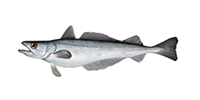Thank you for visiting the Seafood Selector. EDF is planning a new approach to providing information to consumers about good seafood choices. Please come back soon for updates.
Hake

Hake
Recommended servings per month
| Contaminant | Men | Women | Kids 6-12 | Kids 0-5 | |
|---|---|---|---|---|---|
| Argentine hake | Mercury | 4+ | 4+ | 4+ | 3 |
| Cape hake | Mercury | 4+ | 4+ | 4+ | 3 |
| Chilean hake | Mercury | 4+ | 4+ | 4+ | 3 |
| Red hake (US) | Mercury | 4+ | 4+ | 4+ | 3 |
| Silver hake (US) | Mercury | 4+ | 4+ | 4+ | 3 |
| White hake (US) | Mercury | 4+ | 4+ | 4+ | 3 |
| Hoki | Mercury | 4+ | 4+ | 4+ | 3 |
| Pacific whiting | Mercury | 4+ | 4+ | 4 | 3 |
| White hake (Canada) | Mercury | 4+ | 4+ | 4+ | 3 |
Eco details:
- Hake is a relative of cod and is usually caught by gillnets or bottom trawling. This can sometimes result in bycatch and damage to seafloor habitats.
- In New England, hake are now caught under an innovative new ‘sector’ management plan. Discards in the fishery have dramatically decreased, sector fishermen stayed under their catch limits for all groundfish species, and less gear was deployed compared to previous years.




